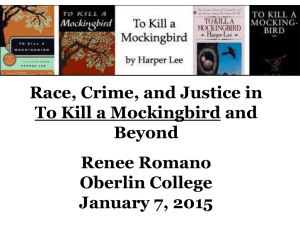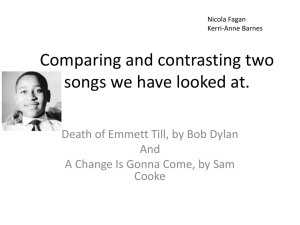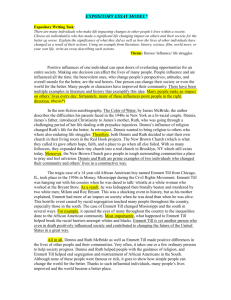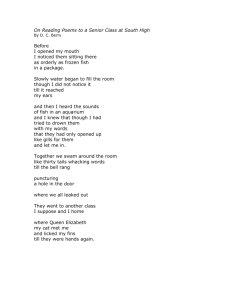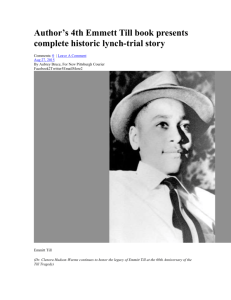File - Katie Kwapick
advertisement
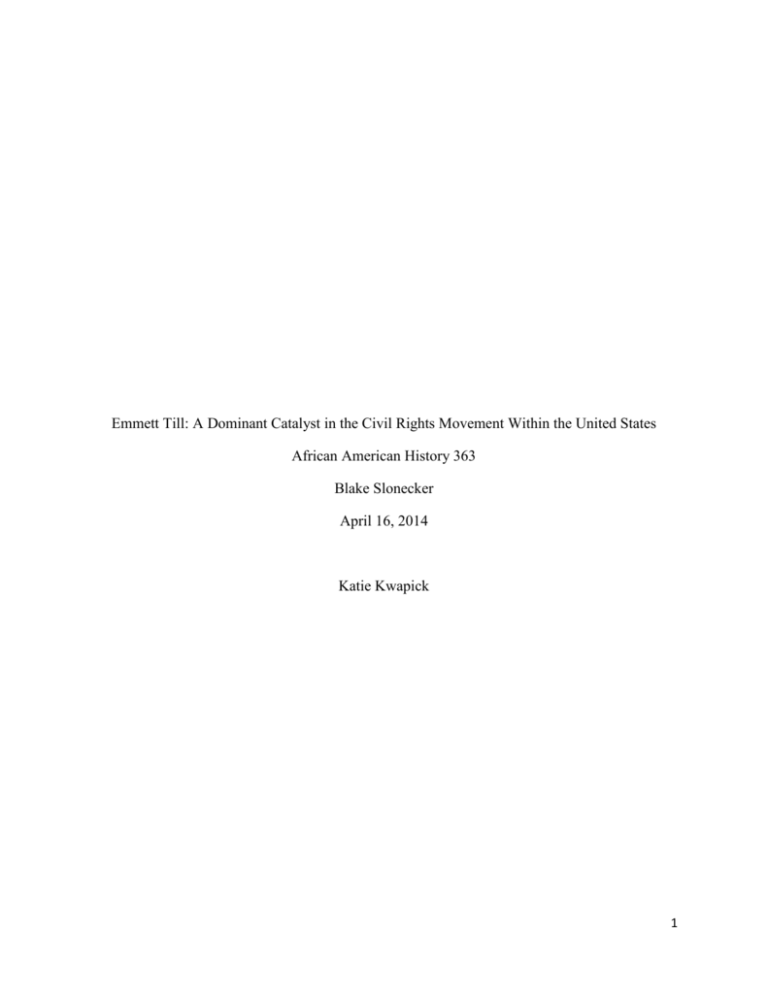
Emmett Till: A Dominant Catalyst in the Civil Rights Movement Within the United States African American History 363 Blake Slonecker April 16, 2014 Katie Kwapick 1 One by one, thousands of men and women from the surrounding area of Chicago file past the dead, mutilated body of Emmett Till. Some weep as they hurry past, and others stop to examine his bloated face, and unrecognizable features. Thousands of people viewed the body over a two day period on Chicago’s South side. And when his funeral begins everyone at the Roberts Temple Church of God in Christ knows what happened to fourteen year old Till, and soon the whole world would too. The South has never been an equal opportunity location for African American’s; for they have spent much of their time doing the dirty work for white America, under the authority of white America. In retrospect, it was only a matter of time before this oppressed minority gained the numbers and confidence to fight back. The murder of Emmett Till sparked, not only the African American population, but white American’s as well, to fight for justice and equality under the law. Although there were several other incidents that can be included in the discussion of civil rights, it was the gruesome murder of Emmett Till that sparked the Civil Rights Movement in America. In the years following the murder of Emmett Till, prominent African American figures, such as Martin Luther King, Jr., Malcolm X, Stokely Carmichael, and Rosa Parks became household names in the fight towards civil liberties. Historians, such as Taylor Branch, who wrote King, Parting the Waters1, have contributed King and other valid participants’ efforts with the birth of the Civil Rights Movement. Others, such as William Chafe, identify a connection between public sit-ins and the Civil Rights Movements. More specifically, he attributes the movement with the Greensboro sit-ins in his book Civilities and Civil Rights2. 1 Taylor Branch, King, Parting the Waters: America in the King Years 1954-63 (New York: Simon & Schuster Inc., 1988) 2 Emmett Till was a young boy from Chicago who was sent to spend part of the summer with his aunt and uncle in Money, Mississippi. He was warned by his mother when he departed that the racism in Mississippi was still very much alive and well. “If you have to get on your hands and knees and bow when a white person goes past, do it willingly,”3 she told him. Emmett Till was a confident young African American boy who ignored the Jim Crow south while he resided in Mississippi. On his way out from Bryant’s Grocery and Meat Market on a hot Wednesday afternoon on August 24, 1955, Till reportedly whistled at the white store clerk, Mrs. Carolyn Bryant and said, “Bye, Baby.” Four days later, on the night of Sunday, August 28, 1955, Bryant’s husband, Roy Bryant and his half-brother, J.W. Milam took Till from his uncle’s house and threatened that “If you [Moses Wright] cause any trouble, you’ll never live to be sixtyfive.”4 The men asked for Emmett Till and rode off with him in the back of their truck. Three days after Emmett Till’s disappearance, a young boy spotted a body caught on a tree root in the Tallahatchie River. On August 30, 1955, Till’s body was carried out of the water by local officials. With a seventy-five pound cotton gin fan tied around his neck connected by barbed wire and one eye gouged out, it was evident that Till was tortured and mutilated before his death. In seeing her son, Mamie Till responded by saying, “I saw a hole, which I presumed was a bullet hole. And I could look through that hole and see daylight on the other side. And I thought, ‘Was it necessary to shoot him?’”5 2 William H. Chafe, Civilities and Civil Rights: Greensboro, North Carolina, and the Black Struggle for Freedom (New York: Oxford University Press, 1980). 3 Kareem Abdul Jabbar and Alan Steinberg, Black Profiles in Courage: A Legacy of African American Achievement (New York: Harper Collins, 2000) 223. Juan Williams, Eyes on the Prize: America’s Civil Rights Years, 1954-1965 (New York: Penguin Inc., 1987) 42. 4 5 Mamie Till Bradley, “The Murder of Emmett Till,” American Experience Documentary, 29:33. 3 Less than three weeks after Till’s body was found in the Tallahatchie River, Roy Bryant and his half-brother, J.W. Milam’s trial began on September 19,1955 in Sumner, Mississippi. A location deemed, “A good place to raise a boy!”6 Twelve all white men from Milam and Bryant’s home town filed in and took their jury seats in the 118° courtroom. Bryant’s defense attorney let the jury converse after this final statement, “Your ancestors would turn over in their graves [if Bryant and Milam are found guilty] and I’m sure every last Anglo-Saxon one of you has the courage to free these men.”7 With that being said, it took five days, and a little over an hour for the jury to deliberate. Roy Bryant and J.W. Milam were found not guilty of murder or kidnapping, due to the state of Mississippi’s failure to identify the body that was pulled from the River three weeks earlier. In reference to the verdict, Sheriff Clarence Strider had this to say: “I hope the Chicago niggers and the NAACP are satisfied.” Four months after their acquittal, J.W. Milam and Roy Bryant sold their story and full testimony to Look Magazine for a fee of fourthousand dollars. After the trial and the article in Look Magazine, Mamie Till along with hundreds of other concerned onlookers, begged President Dwight D. Eisenhower and J. Edgar Hoover to re-open the case as that of a federal issue. She sent a telegram which read, “THE PRESIDENT, THE WHITE HOUSE, I THE MOTHER OF EMMETT LOUIS STILL [sic] AM PLEADING THAT YOU PERSONALLY SEE THAT JUSTICE IS METED OUT TO ALL PERSONS INVOLVED IN THE BEASTLY LYNCHING OF MY SON IN MONEY MISS. AWAITING A DIRECT 6 “The Murder of Emmett Till,” 37:28. “Persecution and Prejudices of African American’s,” Cultural Experiences of African Americans, Accessed April 19, 2014, http://africanamericanculture.weebly.com/index.html. 7 4 REPLY FROM YOU, MAMIE E BRADLEY.”8 Eisenhower declined to reply to her telegram as well as her request to re-open the case, however her contributions neither began nor ended here. Mamie Till Bradley buried her son a few weeks prior. As the body had been shipped to Chicago from Mississippi, the mortician was instructed to keep the cedar coffin closed. Emmett Till’s mother demanded that the box be opened, so she could see her son. An argument arose, and Ms. Till explained that if Mr. Rainer didn’t open her son’s casket, then she would. The box, which was nailed shut, was opened, and the smell of a decomposing body seeped out as Mamie Till focused her eyes on her son. Inspecting his gouged out eyeball, his nose which was broken in several places, and the bullet hole which Ms. Till assumed killed him. “Mr. Rainer asked me, ‘Do you want me to touch the body up.’ I said, ‘No, Mr. Rainer, let the people seen what I’ve seen.’ I was just willing to bear it all. I think everybody ought to know what happened to Emmett Till.”9 Mamie Till Bradley displayed her son’s dead body for a two day wake with an open casket, followed by a funeral. This act has gone down in history as one of the most meaningful protests in the Civil Rights Movement. An American Experience Documentary titled “The Murder of Emmett Till” described the transition between the lynching of a fourteen year old African American boy and the Civil Rights Movement like this, “No one ever did time for the killing of the fourteen year old black boy from Chicago, but his murder and the trial and acquittal of his killers sent a powerful message. If change was going to come, people would have to put themselves on the line. Contributions to civil rights groups soared and one hundred days after the death of Emmett Till, Rosa Parks Mamie Till Bradley, “Telegram to President Dwight D. Eisenhower,” Freedom on My Mind: A History of African Americans with Documents (BostonL Bedford/St. Martins, 2013) 638. 8 9 Mamie Till Bradley, “The Murder of Emmett Till,” 29:49. 5 refused to give up her seat to a white person and the Montgomery Bus Boycott began.”10 There is debate on whether or not this was the last straw for African American’s or if it was a violent act which sparked a radical movement. Regardless, it goes down in history as a major catalyst in Civil Rights. In reference to the afore mentioned American Experience film, it was said that Ms. Parks with backing by the NAACP, single-handedly began the Bus Boycotts in Montgomery. Rosa Parks is quoted in reflecting on her contribution during the Boycotts as saying, "I thought about Emmett Till, and I could not go back. My legs and feet were not hurting, that is a stereotype. I paid the same fare as others, and I felt violated."11 In this reflection, Parks admits that the follow through of her actions were directly correlated to Emmett Till’s lynching. She admits that her walking onto that bus and refusing to give up her seat was because of the violence that was prevalent in the south and the negligence that was carried out in Mississippi. There was cultural backlash that was recognizable to the general public, both black and white. A black journalist reported, “I think black people’s reaction was so visceral, and I think it was probably more than anything else in terms of the mass civil rights movement, the spark that launched it. Everybody knew we were under attack and that attack was symbolized by the attack on a fourteen year old boy.”12 Here, Rose Jourdain explains that the black population reacted, not only in an aggressive manner, but in a manner that would change the way of life. She claims that African American’s had a right to be angry and white American’s knew it. Jourdain explains that this event marked a very obvious catalyst in the Civil Rights Movement. 10 “The Murder of Emmett Till,” 51:02. 11 Nikki Giovanni, A Literary Biography (Santa Barbra: ABC-CLIO, LLC, 2013) 154. 12 Rose Jourdain, “The Murder of Emmett Till,” 31:39. 6 As the former Governor of Mississippi, William Winter agrees with Jourdain. In his interview in the American Experience Documentary, “The Murder of Emmett Till,” he explains, “The Till case held the whole system up for inspection by the rest of the country and by the rest of the world. It was the beginning of the focusing on the problems between the races in the deep south that culminated in the ultimate civil rights battles of the rest of the 50’s and into the 60’s.”13 Winter believes that this was only a matter of time before something like this happened. He argues that it was beneficial for the south and the rest of the world to experience a dramatic event like the murder of Emmett Till to open their eyes and focus on change. This, in turn, would lead to a Civil Rights Movement in America. African American’s have been persecuted throughout American history for being the wrong color, affiliated with the wrong religion, the wrong background and the negative connotation attached those aspects. This blatant racism, which was predominantly centered in the south throughout the 20th Century, very obviously led to an increase in many African American’s fighting for equality and fair treatment under the law. Historians have argued when the Civil Rights Movement was born and what specific event got the ball moving. Due to the positive correlation between prominent leaders such as King and Malcolm X in conjunction with the Civil Rights Movement in America, many historians point to them as the tools responsible for beginning of the fight. Yet John Dittmer, the author of Local People: The Struggle for CivilRights in Mississippi,14 and Charles Payne, who wrote, I’ve Got the Light of Freedom15, both 13 William Winter, “The Murder of Emmett Till” 2:25. 14 John Dittmer, Local People: The Struggle for Civil Rights in Mississippi (Chicago: University of Illinois Press, 1995) 15 Charles M. Paine, I’ve Got the Light (Berkley: University of California Press, 2007) 7 argue that it was ordinary African American’s, who felt the wrath of white dominance and fought hard to overcome their oppressors. Other historians, such as Alex Haley who wrote the very dominant autobiography, the Autobiography of Malcolm X16 and Michael Eric Dyson who wrote Making Malcolm17 argue that African American radicals were responsible for the movement of the Civil Rights Movement. None of these arguments are wrong, none of them are incorrect, or ill-informed. They simply did not have the same outcome or effect that the murder of Emmett Till had. Emmett Till was a major catalyst in the beginning of the Civil Rights Movement, because no matter what color you were in 1955, you still saw the picture of a fourteen year old boy, lying in a casket, far too young, bloated, and unrecognizable. The Till murder struck a chord with the American people, because it portrayed blatant hate, racism and discrimination by two men who never second guessed what they were doing and were never held responsible for their actions. The murder of Emmett Till sparked backlash from all over the United States and in turn fueled both African American and white American’s to fight for equality following this gruesome event. Prior to 1955 and the murder of Emmett Till, well organized, driven protests and civil rights attempts were few and far between. The lynching of African American’s by white American’s, however, were not. The murder of Emmett Till was not the first, and he would not be the last black boy to be killed in the south. However, the reaction which led to the Civil Rights Movement in American can be linked to Emmett Till’s age, the gruesome, brutal murder, the extensive media coverage, and the lack of follow through by the American justice system. Emmett Till’s life being forcefully taken at the hands of two extremely racist individuals after 16Alex Haley, Autobiography of Malcolm X (New York: The Ballantine Publishing Company, 1973) 17Michael Eric Dyson, Making Malcolm (New York: Oxford University Press, 1995.) 8 fourteen short years of life, was an eye-opener for, not only the American public, but the world as they caught wind of it at well. The murder of Emmett Till was the perfect storm for an African American revolution. 9 Bibliography Branch, Taylor. King, Parting the Waters: America in the King Years 1954-63. New York, Simon & Schuster Inc. 1988. Chafe, William H. Civilities and Civil Rights: Greensboro, North Carolina, and the Black Struggle for Freedom. New York, Oxford University Press, 1980. Dittmer, John. Local People: The Struggle for Civil Rights in Mississippi. Chicago, University of Illinois Press, 1995. Dyson, Michael Eric. Making Malcolm. New York, Oxford University Press, 1995. Giovanni, Nikki. A Literary Biography. Santa Barbra: ABC-CLIO, LLC, 2013) Haley, Alex. Autobiography of Malcolm X. New York, The Ballantine Publishing Company, 1973. Jabbar, Kareem Abdul and Steinberg, Alan. Black Profiles in Courage: A Legacy of African American Achievement. New York, Harper Collins, 2000. Paine, Charles H. I’ve Got the Light. Berkley, University of California Press, 2007. “Persecution and Prejudices of African American’s.” Cultural Experiences of African Americans. Accessed April 19, 2014, http://africanamericanculture.weebly.com/index.html. “The Murder of Emmett Till.” American Experience Documentary, PBS. White, Deborah Gray, Bay, Mia and Martin, Waldo E Jr. Freedom on My Mind: A History of African Americans with Documents. Boston, Bedford/St. Martins, 2013. Williams, Juan. Eyes on the Prize: America’s Civil Rights Years, 1954-1965. New York, Penguin Inc., 1987. 10
